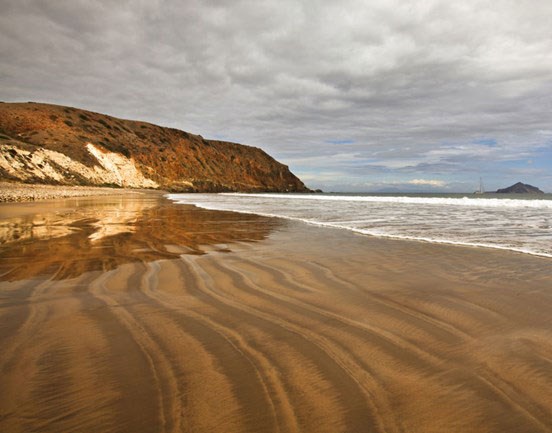Last updated: June 14, 2024
Article
NPS Geodiversity Atlas—Channel Islands National Park, California
Geodiversity refers to the full variety of natural geologic (rocks, minerals, sediments, fossils, landforms, and physical processes) and soil resources and processes that occur in the park. A product of the Geologic Resources Inventory, the NPS Geodiversity Atlas delivers information in support of education, Geoconservation, and integrated management of living (biotic) and non-living (abiotic) components of the ecosystem.

Introduction
Channel Islands National Park (CHIS) is located off the coast of southern California in Santa Barbara and Ventura Counties. Close to the California mainland, yet worlds apart, the park includes five of the eight Channel Islands (Anacapa, Santa Cruz, San Miguel, Santa Rosa, and Santa Barbara) and the surrounding one nautical mile of marine waters. Originally designated as a national monument on April 26, 1938, CHIS was redesignated as a national park on March 5, 1980 (Anderson 2017). The park encompasses 100,994 hectares (249,561 acres) and preserves a wealth of natural and cultural resources ranging from more than 2,000 plant and animal species to hundreds of archeological sites as old as the late Pleistocene (Tweet et al. 2020). The islands are wonderful places to explore history, hike, camp, snorkel, kayak, birdwatch, take photographs, sketch, or just relax to the sounds of the natural world. The park was designated a Biosphere Reserve in 1976.
Geologic Setting
The geology of CHIS records a history of changes governed by plate tectonics in the region of southern California. The northern Channel Islands have been part of a complex 30-million-year-long series of events associated with the collision of the North American and Pacific Plates, leading to displacement and rotation of the Transverse Ranges and related volcanism (Weigand et al. 2002). Each of the five islands of CHIS has a distinct geologic history. Anacapa Island and Santa Barbara Island, the two smallest islands, are primarily composed of Miocene volcanic rocks interfingered with minor amounts of sedimentary rock and covered with a veneer of Quaternary sediments. San Miguel Island and Santa Rosa Island consist primarily of Eocene and Miocene units, with the oldest rocks of San Miguel Island dating to the Late Cretaceous. Santa Cruz Island has the most varied geology of the islands, as well as the longest rock record exposed at the surface in terms of rock age, beginning with Jurassic metamorphic and intrusive igneous rocks (Tweet et al. 2020).
Regional Geology
Channel Islands National Park is a part of the Los Angeles Ranges section of the Pacific Border Physiographic Province and shares its geologic history and some characteristic geologic formations with a region that extends well beyond park boundaries.
- Scoping summaries are records of scoping meetings where NPS staff and local geologists determined the park’s geologic mapping plan and what content should be included in the report.
- Digital geologic maps include files for viewing in GIS software, a guide to using the data, and a document with ancillary map information. Newer products also include data viewable in Google Earth and online map services.
- Reports use the maps to discuss the park’s setting and significance, notable geologic features and processes, geologic resource management issues, and geologic history.
- Posters are a static view of the GIS data in PDF format. Newer posters include aerial imagery or shaded relief and other park information. They are also included with the reports.
- Projects list basic information about the program and all products available for a park.
Source: NPS DataStore Saved Search 2806. To search for additional information, visit the NPS DataStore.
A NPS Soil Resources Inventory project has been completed for Channel Islands National Park and can be found on the NPS Data Store.
Source: NPS DataStore Saved Search 2757. To search for additional information, visit the NPS DataStore.

Related Links
Related Articles
Channel Islands National Park
National Park Service Geodiversity Atlas
The servicewide Geodiversity Atlas provides information on geoheritage and geodiversity resources and values within the National Park System. This information supports science-based geoconservation and interpretation in the NPS, as well as STEM education in schools, museums, and field camps. The NPS Geologic Resources Division and many parks work with National and International geoconservation communities to ensure that NPS abiotic resources are managed using the highest standards and best practices available.
